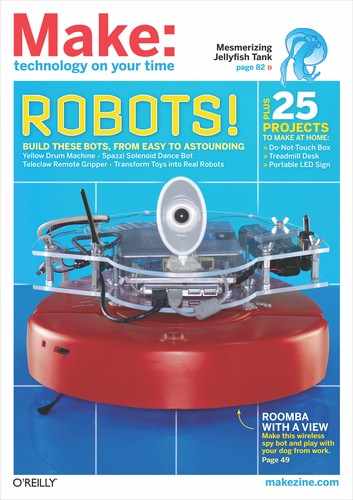MAKE FREE
Four Horsemen of the 3D Printing Apocalypse
CHARLES STROSS’ EXCELLENT NEW
novel, Rule 34 (Ace Books), is a futuristic police procedural set in a near-future Edinburgh, in which 3D printing has become boringly ubiquitous.
You can buy safe, prepackaged 3D printers at the local housewares shop, and they’re handy for whipping up generic replacement parts for broken appliances (at one point a character drops and cracks his wife’s cherished German onion slicer and realizes he’ll have to google for a 3D file to match the broken piece) or paid-for 3D files licensed from big media companies.
These printers are controlled by DRM that checks jobs against a blacklist of forbidden shapes and prevents them from being output if they match (presumably there’s some loose matching algorithm in use that can get past ruses like simple changes to the shape).
Of course, this doesn’t work. The bad guys handily outmaneuver the prohibitionists, and a black market springs up, producing such wicked marvels as solid-state meth labs, brass knuckles made from super-hard polymers, and X-ray-invisible, nonferrous stick-up knives.
I think Stross’ speculation on the future of 3D printing gets the shape right, even if the details might not match exactly. Since the early days of computer regulation, hysterics have made recourse to the “Four Horsemen of the Infocalypse”: child pornographers, organized crime, terrorists, and pirates. Invoking one or more of these terrible fellows is often sufficient to stifle further debate and end critical thought (“Won’t someone think of the children?!”).
It’s not that bad guys don’t use our beloved machines to do bad things. But a prohibition against running certain programs is a non-starter. In practice, a computer’s owner can, with sufficient technical knowledge (or access to a large, searchable database of general knowledge, such as the internet), trivially unlock her device so that it can execute any valid program.
But when all you have is a hammer, everything starts to look like a nail. In Stross’ world, as in our own, the regulatory response is to build devices that have internal snitches that check to see if their owners are running naughty unlocking programs. And in Stross’ world, as in our own, the need to prevent the dissemination of snitchware countermeasures leads to widespread surveillance and censorship of the internet.
Pro-regulation hysterics make recourse to the Four Horsemen of the Infocalypse: child porn, organized crime, terrorists, and pirates.
And in Stross’ world, as in ours, none of this actually works worth a damn at stopping bad guys. Instead, it creates a vicious cycle of more surveillance and more control to overcome the failings of the current round of censorship and surveillance.
Rule 34 abounds with imaginative horrors about the potential for technology to do bad, and as imaginative as Stross is, I’m guessing that the real thing will be even ickier.
We need real solutions to the bad stuff that people come up with when they get technology. The first step to finding a real solution is to stop doing things that don’t work. ![]()
Cory Doctorow’s latest novel is Makers (Tor Books U.S., HarperVoyager U.K.). He lives in London and co-edits the website Boing Boing.

